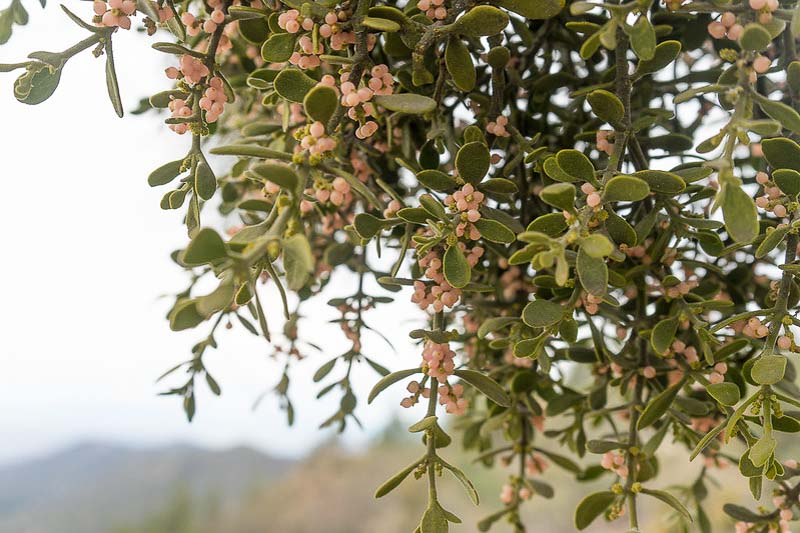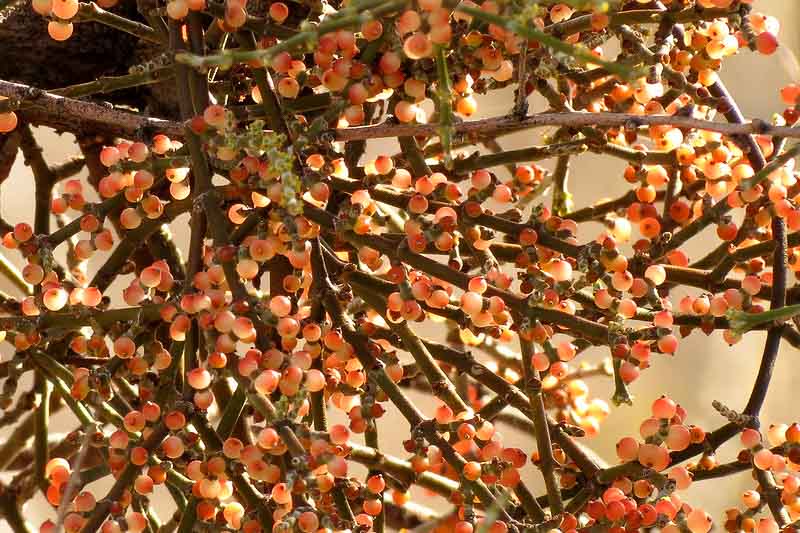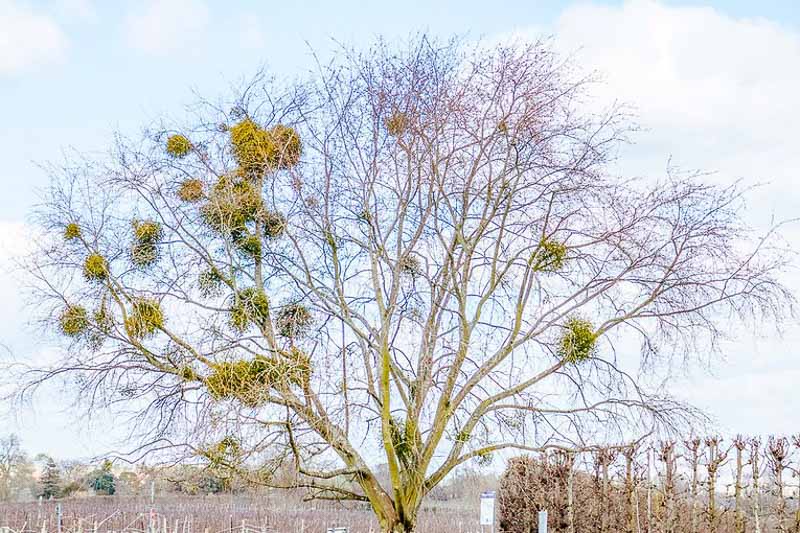What is Mistletoe?
Mistletoe is a common name that encompasses a range of parasitic plants that attach themselves to trees and shrubs, extracting water and nutrients. While often associated with Christmas traditions, mistletoe is an ecological concern due to its parasitic nature, which can weaken and even kill host plants. Its evergreen leaves contrast starkly with the deciduous trees it frequently infests.
Types of Mistletoe
Mistletoes are parasitic plants that have a rich diversity with more than 1,300 species worldwide. Different species are adapted to their specific host plants, and their parasitic relationship can range from relatively harmless to severely damaging or even lethal to the host tree. Some trees can support a mistletoe plant for many years with little detrimental effect, while in other cases, heavy infestations can weaken a tree and make it more susceptible to other pests and diseases. Here’s a breakdown of the more common types:
European Mistletoe (Viscum album):
- Region: Europe and parts of Asia.
- Description: This is perhaps the most famous type, especially in European cultures. It commonly parasitizes apple trees, but can also be found on poplar, lime, and other deciduous trees. The plant has smooth-edged, oval, evergreen leaves borne in pairs along the woody stem and waxy, white berries that are in clusters of two to six.
American Mistletoe (Phoradendron serotinum):
- Region: Primarily North America.
- Description: It’s very similar in appearance to the European mistletoe but is native to the U.S. and found on a variety of deciduous trees, such as oak, walnut, and elm.
Dwarf Mistletoes (Genus Arceuthobium):
- Region: Predominantly North America.
- Description: These are most destructive to conifer forests (pines, firs, spruces, cedars, etc.). Unlike the leafy European and American mistletoes, dwarf mistletoes are leafless, and their yellowish or greenish stems appear more broom-like.
Australian Mistletoes:
- Region: Australia.
- Description: Over 90 species of mistletoe are native to Australia. They are found on various trees, including eucalyptus, acacia, and casuarina. One of the most notable is the Box Mistletoe (Amyema miquelii), which has broad, thick leaves and parasitizes several tree types.
Leafy Mistletoe (Phoradendron leucarpum):
- Region: Parts of North and South America.
- Description: This mistletoe is found on deciduous trees, and it’s known for its smooth, oval leaves and clusters of red berries.
Oak Mistletoe (Phoradendron villosum):
- Region: Primarily western North America.
- Description: As the name suggests, this mistletoe prefers oak trees. It has broader leaves compared to other types and produces small, sticky white berries.
Desert Mistletoe (Phoradendron californicum):
- Region: Deserts of the U.S. Southwest.
- Description: This type has a distinct appearance with its red, segmented stems and lacks noticeable leaves. It’s well-adapted to desert conditions and primarily parasitizes desert trees.
Ribbon-leaf Mistletoe (Notanthera heterophylla):
- Region: Australia.
- Description: This mistletoe has a striking appearance with its long, ribbon-like leaves.
 Mistletoe growing on the branch of an oak tree
Mistletoe growing on the branch of an oak tree
What Causes Mistletoe on Trees?
The establishment and spread of mistletoe in trees are primarily caused by the following factors:
- Bird Dispersal: The most common method of mistletoe spread is through birds. Birds eat the berries and the seeds, which are sticky, either pass through the bird’s digestive system or adhere to its beak. When the bird perches on a branch and wipes its beak or excretes the seeds, the seeds stick to the tree. The sticky coating, called viscin, helps the seed adhere to the host plant.
- Seed Germination: Once adhered to a suitable host, the seed germinates, and the mistletoe’s specialized root, called a haustorium, penetrates the tree’s bark and begins drawing nutrients and water from the tree’s vascular system.
- Host Preference: Different mistletoe species have preferred host species. When these preferred hosts are present in an ecosystem with the corresponding mistletoe species, the likelihood of infestation increases.
- Previous Infestations: Trees that have been previously infested with mistletoe are more susceptible to subsequent infestations, especially if the mistletoe was not entirely removed or if nearby trees are heavily infested and act as a source of new seeds.
- Human-Mediated Spread: Sometimes, human activities, like pruning infested trees and discarding cut branches near healthy trees, can facilitate the spread of mistletoe.
It’s important to note that mistletoe doesn’t “infect” trees in the same way a fungal pathogen or virus might. Instead, it’s a plant that has evolved a parasitic relationship with its host trees. While it does take nutrients and water from the host, mistletoe also performs photosynthesis and produces its own food, classifying it as a hemiparasite. In some ecosystems, mistletoe plays an essential ecological role, providing food and habitat for various species. However, in others, especially when introduced outside its native range, it can become a significant pest and weaken or kill host trees.
 Desert Mistletoe (Phoradendron californicum)
Desert Mistletoe (Phoradendron californicum)
How Much Damage Does Mistletoe Do?
Mistletoe, as a semi-parasitic plant, does derive its sustenance from host trees, which can lead to a range of damages depending on the severity of the infestation and the overall health of the host. Here’s a breakdown of the damage it can cause:
- Nutrient and Water Deprivation: Mistletoe roots, known as haustoria, tap into the tree’s water and nutrient channels. Over time, this can weaken the host tree, particularly if there’s a significant infestation.
- Stress: Trees heavily infested with mistletoe may experience stress, making them more susceptible to diseases, pests, and adverse environmental conditions.
- Branch Death: As the mistletoe grows, it can cause girdling of branches, leading to dieback or the eventual death of branches. This can disfigure the tree and also reduce its photosynthetic capacity.
- Decreased Growth and Vigor: Affected trees often display stunted growth and reduced vigor due to the diversion of nutrients to the mistletoe. Over time, this can result in a decline in the overall health of the tree.
- Increased Susceptibility: Weakened trees are more susceptible to secondary infections, pests, and other environmental stressors.
- Tree Death: In extreme cases, particularly with trees that are already stressed from other factors, a heavy infestation can lead to the death of the tree.
- Structural Damage: The weight of multiple mistletoe plants can cause structural damage to branches, especially during events like storms, potentially leading to falling branches that can damage property or pose safety risks.
- Economic Impact: In timber industries, mistletoe infestations can reduce the value of lumber from affected trees. Moreover, controlling and managing this semi-parasitic plant in orchards and timber forests can result in added costs.
- Biodiversity Impacts: On the flip side, mistletoe can have positive ecological effects in some environments. They provide food for various animals, including birds that feed on their berries. Additionally, they offer nesting sites for certain bird species. Thus, while they can be harmful to individual trees, they play a role in biodiversity.

Mistletoe Cultural Importance
Mistletoe holds a special place in various cultures around the world, with its significance spanning from ancient rituals to modern traditions. Here’s an overview of its cultural importance:
- Ancient Significance: In ancient cultures, mistletoe was often viewed with reverence due to its peculiar habit of growing without roots in the soil, suggesting to early peoples that it was a gift from the heavens. The Druids, for instance, believed it had magical properties, bringing luck, fertility, and protection against evil spirits.
- Norse Mythology: In Norse legends, mistletoe plays a tragic role in the death of Baldur, the god of purity and light. It was the only plant that did not swear an oath not to harm Baldur, making it the tool of his demise. However, it later becomes a symbol of love and rebirth.
- Christmas Tradition: In many Western cultures, mistletoe is a staple of Christmas decorations. The custom of kissing under the mistletoe during the Christmas season can be traced back to ancient festivals like Saturnalia and later incorporated into Christmas traditions.
- Symbol of Peace and Love: In some traditions, mistletoe was seen as a symbol of peace and reconciliation. Warring parties would call a truce if they met under mistletoe in the forest. Similarly, quarreling spouses would make up under mistletoe.
- Medicinal Uses: Historically, mistletoe was used in traditional medicine in various cultures. Its uses ranged from treating epilepsy in ancient Greece to remedies for various ailments in European folklore. Today, some preparations of European mistletoe are being studied for potential anti-cancer properties.
- Literature and Art: Mistletoe has inspired poets, writers, and artists over the centuries. Its intriguing nature and deep-rooted traditions make it a popular subject or motif, especially around the winter season.
- Cultural Festivals: Certain regions have festivals centered around mistletoe. For instance, Tenbury Wells in England hosts an annual mistletoe festival, celebrating the plant and its cultural significance.
- Protection Against Evil: In some European traditions, mistletoe, especially when hung at the doorway, was believed to ward off witches and evil spirits. Its evergreen nature in the winter months made it a powerful symbol of endurance and spiritual strength.
- New Year’s Eve Traditions: In some cultures, it’s customary to burn mistletoe, not just kiss beneath it. Burning last year’s decoration is thought to prevent bad luck in the coming year.
- Modern Symbolism: Today, beyond its festive connotations, mistletoe serves as a broader symbol of life persisting in the harshest conditions, given its ability to thrive during the cold winter months when most plants are dormant.
In all these contexts, mistletoe stands as a testament to how nature intertwines with human culture, shaping beliefs, traditions, and daily practices.
Is Mistletoe Toxic?
Mistletoe is an intriguing plant with deep-rooted cultural significance, especially during the holiday season. However, it’s crucial to be aware of its potential toxicity, especially if you have it around your home.
- Toxic Components: The berries, leaves, and stems of many mistletoe species contain compounds that can be toxic when ingested. These compounds include viscotoxin (in European mistletoe) and phoratoxin (in American mistletoe).
- Ingestion: If ingested, mistletoe can cause symptoms such as stomach pain, diarrhea, and vomiting. In more severe cases, it can lead to difficulty breathing, slowed heartbeat, and seizures.
- Berries: Of all parts of the mistletoe plant, the berries often draw the most concern due to their attractive appearance, especially to children and pets. Even though the berries of some mistletoe species are less toxic than others, it’s prudent to consider all mistletoe berries as potentially harmful if ingested.
- Skin Contact: Some people might experience skin irritation or an allergic reaction upon touching mistletoe or its sap.
- Pets: Dogs and cats that ingest mistletoe can experience symptoms like vomiting, diarrhea, difficulty breathing, and even slowed heart rate. It’s essential to keep mistletoe out of reach of pets.
Precautions and Recommendations:
- Out of Reach: If you’re using real mistletoe as a decoration, make sure it’s well out of reach of children and pets.
- Artificial Alternatives: Consider using artificial mistletoe as a safer alternative, especially if there’s a risk of children or pets coming into contact with it.
- Emergency Situations: If someone ingests mistletoe, it’s crucial to seek medical attention immediately. Having a quick reference to local emergency numbers or poison control centers can be beneficial.
- Educate: If you have real mistletoe in your home, make sure all family members, especially children, are informed about its potential dangers.
In conclusion, while mistletoe holds a cherished spot in holiday traditions, it’s essential to handle and display it with care, ensuring that this festive plant remains a symbol of joy rather than a cause for concern.
While every effort has been made to describe these plants accurately, please keep in mind that height, bloom time, and color may differ in various climates. The description of these plants has been written based on numerous outside resources.
 Mistletoe growing on the branch of an oak tree
Mistletoe growing on the branch of an oak tree Desert Mistletoe (Phoradendron californicum)
Desert Mistletoe (Phoradendron californicum)